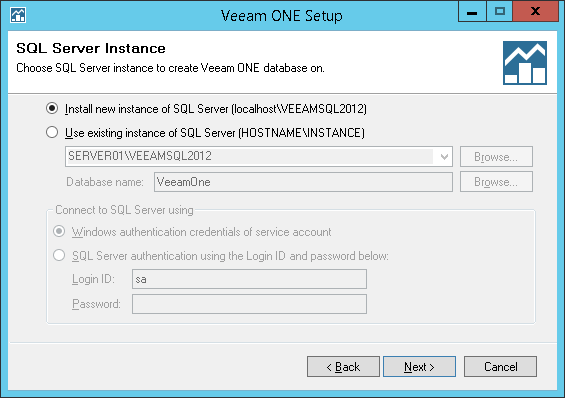At the SQL Server Instance step of the wizard, choose a SQL Server instance that will host the Veeam ONE database.
- If you do not have a SQL Server instance that you can use for Veeam ONE, select the Install new instance of SQL Server option.
If this option is selected, the setup will install SQL Server 2012 Express locally, on the computer where you are installing Veeam ONE.
|
If a SQL Server instance that meets Veeam ONE system requirements is detected on your machine, you can only use the existing local SQL Server instance or choose a one that runs remotely. The option to install a new SQL instance will be unavailable in this case. |
- If you want to use an existing local or remote SQL Server instance, select the Use existing instance of SQL Server option and choose a local SQL Server instance or browse to a SQL Server instance running remotely. You can enter the address of the preferred SQL Server manually or use the Browse button to choose among available remote instances.
In the Database name field, enter the name of the database that will be created by Veeam ONE. Provide valid credentials for the account that will be used by Veeam ONE components to access the SQL Server database. You can enter credentials explicitly or use Windows authentication to connect to the SQL Server. Note that the account must have System Administrator rights on the selected SQL Server instance.
- If you already have an existing Veeam ONE database that you want to use in your deployment (this can be a database that you have previously created with a SQL script), select the Use existing instance of SQL Server option and choose the SQL Server instance that hosts the database. In the Database name field, enter the name of the database.
Provide valid credentials for the account that will be used by Veeam ONE components to access the SQL Server database. You can enter credentials explicitly or use Windows authentication to connect to the SQL Server. Note that the account must have System Administrator rights on the selected SQL Server instance.








